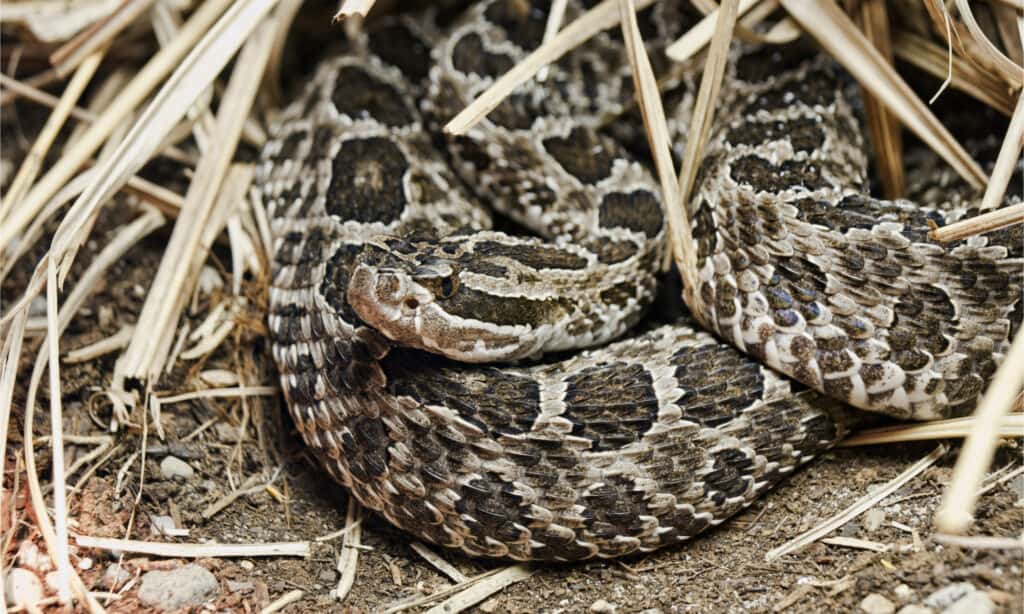The further north you travel, the fewer snakes you’ll see, especially venomous snakes. However, during the spring in Michigan, rattlesnakes become active. The sun’s warmth brings all the reptiles out to play! Unfortunately, for many people, snakes are right out of a nightmare. So when you bring venom to the picture, it’s even worse.
However, knowledge is power! Taking a little time to understand these misunderstood creatures can help reduce your fear.
Which Rattlesnakes Live In Michigan?

Eastern massaugas are more common in the southern half of Michigan.
©DnDavis/Shutterstock.com
Michigan is farther north than most rattlesnakes can live because the climate is too cool overall. So, if rattlesnakes make you nervous, you’ll be happy to hear that there is only one rattlesnake species in Michigan.
The Eastern Massasauga is one of the smallest rattlesnakes in the world. Considering that the biggest individuals only measure about 30 inches, people sometimes mistake them for babies of other rattlesnake species. However, this snake starts and ends small.
Eastern massasaugas have a light gray or brown base color, dark brown or black rounded blotches on the back, and smaller blotches on the sides. Its broad triangular head and vertical pupils help mark it as a venomous snake, but the rattle at the end of its tail really gives it away.
Where to Find Eastern Massaugas in Michigan
Although their range historically covered most of Michigan’s southern peninsula, most of the recently confirmed populations are in the southern half.
You’ll find this small rattlesnake in wetland habitats — hiding under woody debris or vegetation. Bogs, fens, wet meadows, marshes, and similarly wet habitats make eastern massasaugas feel at home. However, this timid snake is secretive, shunning anything big enough to be threatening.
Eastern massasaugas use the same brumation dens every year, making protecting enough natural habitat vital to their survival. In addition, studies show that eastern massasaugas do not survive the winter after they’re relocated from their original range.
At this point, it looks like Michigan is the only state where massasaugas have a healthy population. As a result, maintaining that population is essential to the species’ survival.
When Eastern Massasauga Rattlesnakes Are Most Active in Michigan
Like other reptiles, eastern massasaugas rattlesnakes are active from spring to fall in Michigan, from April to October. Michigan rattlesnake sightings peak in July and August and taper sharply before and after.
Michigan’s shorter warm season means they sometimes tuck into their dens for the winter. Most of the massasauga’s spring activity includes basking on the tops of hills, beaver lodges, and other elevated locations. Once the weather warms them enough, they move on to their summer territory, usually less than two miles away.
During the spring and fall, eastern massasaugas are more active during the day, but as the weather heats up, their schedules change to evenings and nights.
What’s Special About Rattlesnakes?
Rattlesnakes are highly evolved, with long, hollow fangs that inject venom deeply into prey.
They’re unique in the world.
Although a few snake species have specialized tail hardware, none are quite so widespread among a snake family.
Scientists believe rattlesnakes developed their rattle as a direct response to the bison herds that once covered North America’s plains. So they needed to warn these huge animals so the snakes didn’t get stepped on.
In addition to the astonishing early-warning system, rattlesnakes are pit vipers. These snakes have a special heat-sensing pit between each eye and nostril. Their pits give them 3D night vision to strike accurately, even on a dark moonless night.
Eastern massasaugas eat various small animals like mice, small rats, birds, and their eggs. They’ll also eat lizards, other snakes, and insects. Snakes are among nature’s most effective pest controls! These animals can get into tiny nooks and crannies that keep bigger predators out.
How Dangerous Are Eastern Massasaugas
Thanks to their timid disposition, they don’t bite often. So you’re only likely to get bitten if you step on an eastern massasauga or pick it up.
Their venom is cytotoxic and destroys tissue. In prey animals, the venom causes internal bleeding and prevents blood clotting.
Eastern massasaugas are food for any meat-eating animal larger than them, so camouflage is their best bet. So, they’re more likely to tuck in and hope you don’t see them!
But, if you’re bitten, it’s a medical emergency. Head straight for a hospital.
Rattlesnake Bite First Aid

Most bites occur when humans accidentally step on or near a rattlesnake or attempt to handle or kill one.
©Chuanpit/Shutterstock.com
The good news is that, even if a rattlesnake bites you, antivenom is effective and available at hospitals everywhere eastern massasaugas live.
Here are a few tips, according to the Mayo Clinic:
- Move away from the snake’s striking distance.
- Keep calm. Stress and adrenaline make the venom spread faster.
- Take off your jewelry and tight clothing. Rattlesnake bites can cause massive swelling.
- Clean the wound and cover it. No need to make things worse with an infection.
- Do not use a tourniquet. Applied incorrectly, they cause more damage.
- Do not try to suck out the venom. It’s injected too deeply for anyone to reach.
- Do not drink caffeine or alcohol. They thin the blood and can make the venom’s effects worse.
- Do not try to capture the snake. Memorize its color and shape. If possible, get a photo of it from a safe distance.
Other Michigan Snakes
Miniature rattlesnakes aren’t the only snake species you’ll find in Michigan. Here are a few:
The photo featured at the top of this post is © Ryan M. Bolton/Shutterstock.com
Discover the "Monster" Snake 5X Bigger than an Anaconda
Every day A-Z Animals sends out some of the most incredible facts in the world from our free newsletter. Want to discover the 10 most beautiful snakes in the world, a "snake island" where you're never more than 3 feet from danger, or a "monster" snake 5X larger than an anaconda? Then sign up right now and you'll start receiving our daily newsletter absolutely free.
Thank you for reading! Have some feedback for us? Contact the AZ Animals editorial team.






